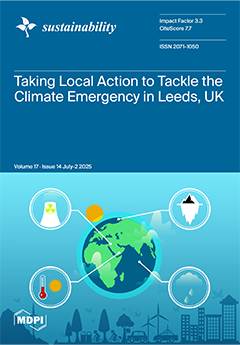The occurrence of haze pollution significantly deteriorates air quality and threatens human health, yet persistent knowledge gaps in real-time source apportionment of fine particulate matter (PM
2.5) hinder sustained improvements in atmospheric pollution conditions. Thus, this study employed single-particle aerosol mass spectrometry
[...] Read more.
The occurrence of haze pollution significantly deteriorates air quality and threatens human health, yet persistent knowledge gaps in real-time source apportionment of fine particulate matter (PM
2.5) hinder sustained improvements in atmospheric pollution conditions. Thus, this study employed single-particle aerosol mass spectrometry (SPAMS) to investigate PM
2.5 sources and dynamics during winter haze episodes in Yinchuan, Northwest China. Results showed that the average PM
2.5 concentration was 57 μg·m
−3, peaking at 218 μg·m
−3. PM
2.5 was dominated by organic carbon (OC, 17.3%), mixed carbonaceous particles (ECOC, 17.0%), and elemental carbon (EC, 14.3%). The primary sources were coal combustion (26.4%), fugitive dust (25.8%), and vehicle emissions (19.1%). Residential coal burning dominated coal emissions (80.9%), highlighting inefficient decentralized heating. Source contributions showed distinct diurnal patterns: coal combustion peaked nocturnally (29.3% at 09:00) due to heating and inversions, fugitive dust rose at night (28.6% at 19:00) from construction and low winds, and vehicle emissions aligned with traffic (17.5% at 07:00). Haze episodes were driven by synergistic increases in local coal (+4.0%), dust (+2.7%), and vehicle (+2.1%) emissions, compounded by regional transport (10.1–36.7%) of aged particles from northwestern zones. Fugitive dust correlated with sulfur dioxide (SO
2) and ozone (O
3) (
p < 0.01), suggesting roles as carriers and reactive interfaces. Findings confirm local emission dominance with spatiotemporal heterogeneity and regional transport influence. SPAMS effectively resolved short-term pollution dynamics, providing critical insights for targeted air quality management in arid regions.
Full article





